Yuni Lai
Stealthy Dual-Trigger Backdoors: Attacking Prompt Tuning in LM-Empowered Graph Foundation Models
Oct 16, 2025Abstract:The emergence of graph foundation models (GFMs), particularly those incorporating language models (LMs), has revolutionized graph learning and demonstrated remarkable performance on text-attributed graphs (TAGs). However, compared to traditional GNNs, these LM-empowered GFMs introduce unique security vulnerabilities during the unsecured prompt tuning phase that remain understudied in current research. Through empirical investigation, we reveal a significant performance degradation in traditional graph backdoor attacks when operating in attribute-inaccessible constrained TAG systems without explicit trigger node attribute optimization. To address this, we propose a novel dual-trigger backdoor attack framework that operates at both text-level and struct-level, enabling effective attacks without explicit optimization of trigger node text attributes through the strategic utilization of a pre-established text pool. Extensive experimental evaluations demonstrate that our attack maintains superior clean accuracy while achieving outstanding attack success rates, including scenarios with highly concealed single-trigger nodes. Our work highlights critical backdoor risks in web-deployed LM-empowered GFMs and contributes to the development of more robust supervision mechanisms for open-source platforms in the era of foundation models.
AuditVotes: A Framework Towards More Deployable Certified Robustness for Graph Neural Networks
Mar 29, 2025Abstract:Despite advancements in Graph Neural Networks (GNNs), adaptive attacks continue to challenge their robustness. Certified robustness based on randomized smoothing has emerged as a promising solution, offering provable guarantees that a model's predictions remain stable under adversarial perturbations within a specified range. However, existing methods face a critical trade-off between accuracy and robustness, as achieving stronger robustness requires introducing greater noise into the input graph. This excessive randomization degrades data quality and disrupts prediction consistency, limiting the practical deployment of certifiably robust GNNs in real-world scenarios where both accuracy and robustness are essential. To address this challenge, we propose \textbf{AuditVotes}, the first framework to achieve both high clean accuracy and certifiably robust accuracy for GNNs. It integrates randomized smoothing with two key components, \underline{au}gmentation and con\underline{dit}ional smoothing, aiming to improve data quality and prediction consistency. The augmentation, acting as a pre-processing step, de-noises the randomized graph, significantly improving data quality and clean accuracy. The conditional smoothing, serving as a post-processing step, employs a filtering function to selectively count votes, thereby filtering low-quality predictions and improving voting consistency. Extensive experimental results demonstrate that AuditVotes significantly enhances clean accuracy, certified robustness, and empirical robustness while maintaining high computational efficiency. Notably, compared to baseline randomized smoothing, AuditVotes improves clean accuracy by $437.1\%$ and certified accuracy by $409.3\%$ when the attacker can arbitrarily insert $20$ edges on the Cora-ML datasets, representing a substantial step toward deploying certifiably robust GNNs in real-world applications.
Defense-as-a-Service: Black-box Shielding against Backdoored Graph Models
Oct 07, 2024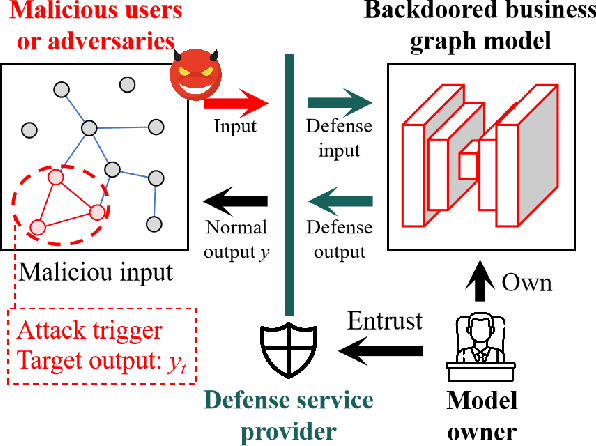
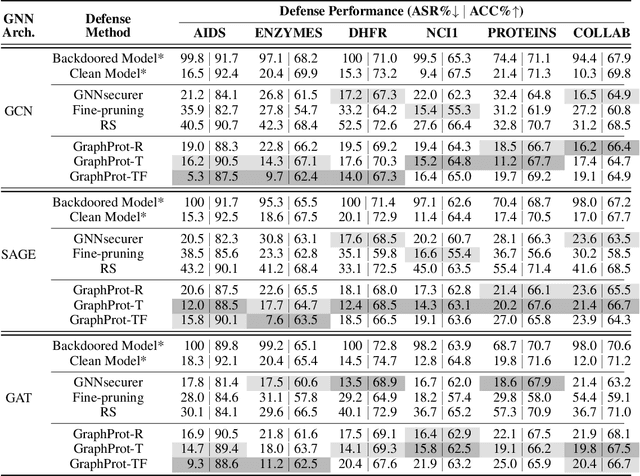
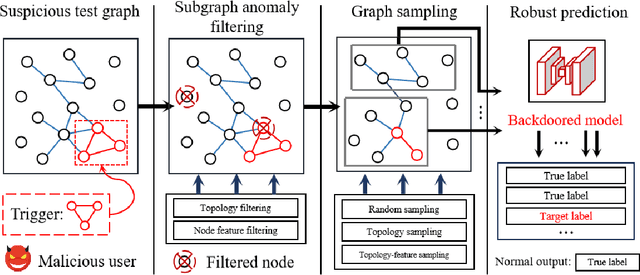

Abstract:With the trend of large graph learning models, business owners tend to employ a model provided by a third party to deliver business services to users. However, these models might be backdoored, and malicious users can submit trigger-embedded inputs to manipulate the model predictions. Current graph backdoor defenses have several limitations: 1) depending on model-related details, 2) requiring additional model fine-tuning, and 3) relying upon extra explainability tools, all of which are infeasible under stringent privacy policies. To address those limitations, we propose GraphProt, which allows resource-constrained business owners to rely on third parties to avoid backdoor attacks on GNN-based graph classifiers. Our GraphProt is model-agnostic and only relies on the input graph. The key insight is to leverage subgraph information for prediction, thereby mitigating backdoor effects induced by triggers. GraphProt comprises two components: clustering-based trigger elimination and robust subgraph ensemble. Specifically, we first propose feature-topology clustering that aims to remove most of the anomalous subgraphs (triggers). Moreover, we design subgraph sampling strategies based on feature-topology clustering to build a robust classifier via majority vote. Experimental results across three backdoor attacks and six benchmark datasets demonstrate that GraphProt significantly reduces the backdoor attack success rate while preserving the model accuracy on regular graph classification tasks.
Collective Certified Robustness against Graph Injection Attacks
Mar 03, 2024Abstract:We investigate certified robustness for GNNs under graph injection attacks. Existing research only provides sample-wise certificates by verifying each node independently, leading to very limited certifying performance. In this paper, we present the first collective certificate, which certifies a set of target nodes simultaneously. To achieve it, we formulate the problem as a binary integer quadratic constrained linear programming (BQCLP). We further develop a customized linearization technique that allows us to relax the BQCLP into linear programming (LP) that can be efficiently solved. Through comprehensive experiments, we demonstrate that our collective certification scheme significantly improves certification performance with minimal computational overhead. For instance, by solving the LP within 1 minute on the Citeseer dataset, we achieve a significant increase in the certified ratio from 0.0% to 81.2% when the injected node number is 5% of the graph size. Our step marks a crucial step towards making provable defense more practical.
Adversarially Robust Signed Graph Contrastive Learning from Balance Augmentation
Jan 19, 2024



Abstract:Signed graphs consist of edges and signs, which can be separated into structural information and balance-related information, respectively. Existing signed graph neural networks (SGNNs) typically rely on balance-related information to generate embeddings. Nevertheless, the emergence of recent adversarial attacks has had a detrimental impact on the balance-related information. Similar to how structure learning can restore unsigned graphs, balance learning can be applied to signed graphs by improving the balance degree of the poisoned graph. However, this approach encounters the challenge "Irreversibility of Balance-related Information" - while the balance degree improves, the restored edges may not be the ones originally affected by attacks, resulting in poor defense effectiveness. To address this challenge, we propose a robust SGNN framework called Balance Augmented-Signed Graph Contrastive Learning (BA-SGCL), which combines Graph Contrastive Learning principles with balance augmentation techniques. Experimental results demonstrate that BA-SGCL not only enhances robustness against existing adversarial attacks but also achieves superior performance on link sign prediction task across various datasets.
Universally Robust Graph Neural Networks by Preserving Neighbor Similarity
Jan 18, 2024Abstract:Despite the tremendous success of graph neural networks in learning relational data, it has been widely investigated that graph neural networks are vulnerable to structural attacks on homophilic graphs. Motivated by this, a surge of robust models is crafted to enhance the adversarial robustness of graph neural networks on homophilic graphs. However, the vulnerability based on heterophilic graphs remains a mystery to us. To bridge this gap, in this paper, we start to explore the vulnerability of graph neural networks on heterophilic graphs and theoretically prove that the update of the negative classification loss is negatively correlated with the pairwise similarities based on the powered aggregated neighbor features. This theoretical proof explains the empirical observations that the graph attacker tends to connect dissimilar node pairs based on the similarities of neighbor features instead of ego features both on homophilic and heterophilic graphs. In this way, we novelly introduce a novel robust model termed NSPGNN which incorporates a dual-kNN graphs pipeline to supervise the neighbor similarity-guided propagation. This propagation utilizes the low-pass filter to smooth the features of node pairs along the positive kNN graphs and the high-pass filter to discriminate the features of node pairs along the negative kNN graphs. Extensive experiments on both homophilic and heterophilic graphs validate the universal robustness of NSPGNN compared to the state-of-the-art methods.
Cost Aware Untargeted Poisoning Attack against Graph Neural Networks,
Dec 12, 2023



Abstract:Graph Neural Networks (GNNs) have become widely used in the field of graph mining. However, these networks are vulnerable to structural perturbations. While many research efforts have focused on analyzing vulnerability through poisoning attacks, we have identified an inefficiency in current attack losses. These losses steer the attack strategy towards modifying edges targeting misclassified nodes or resilient nodes, resulting in a waste of structural adversarial perturbation. To address this issue, we propose a novel attack loss framework called the Cost Aware Poisoning Attack (CA-attack) to improve the allocation of the attack budget by dynamically considering the classification margins of nodes. Specifically, it prioritizes nodes with smaller positive margins while postponing nodes with negative margins. Our experiments demonstrate that the proposed CA-attack significantly enhances existing attack strategies
Node-aware Bi-smoothing: Certified Robustness against Graph Injection Attacks
Dec 07, 2023
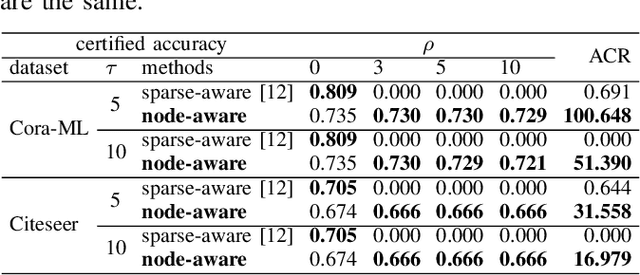
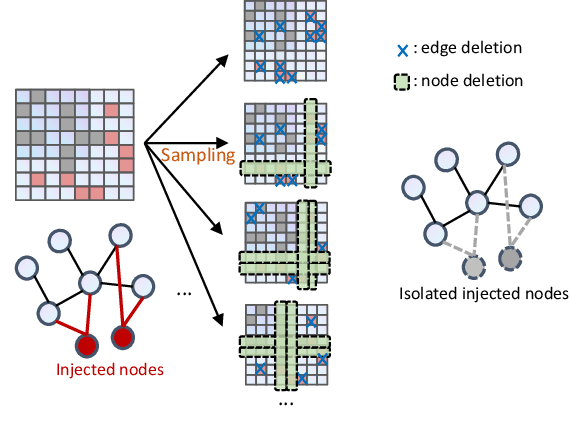
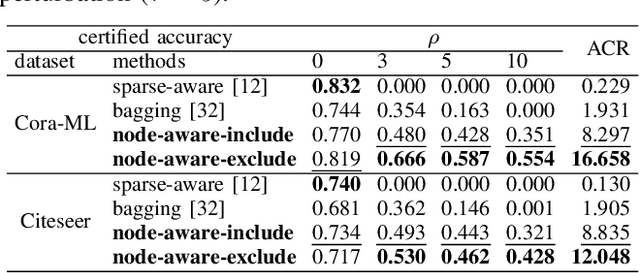
Abstract:Deep Graph Learning (DGL) has emerged as a crucial technique across various domains. However, recent studies have exposed vulnerabilities in DGL models, such as susceptibility to evasion and poisoning attacks. While empirical and provable robustness techniques have been developed to defend against graph modification attacks (GMAs), the problem of certified robustness against graph injection attacks (GIAs) remains largely unexplored. To bridge this gap, we introduce the node-aware bi-smoothing framework, which is the first certifiably robust approach for general node classification tasks against GIAs. Notably, the proposed node-aware bi-smoothing scheme is model-agnostic and is applicable for both evasion and poisoning attacks. Through rigorous theoretical analysis, we establish the certifiable conditions of our smoothing scheme. We also explore the practical implications of our node-aware bi-smoothing schemes in two contexts: as an empirical defense approach against real-world GIAs and in the context of recommendation systems. Furthermore, we extend two state-of-the-art certified robustness frameworks to address node injection attacks and compare our approach against them. Extensive evaluations demonstrate the effectiveness of our proposed certificates.
Dual-Space Attacks against Random-Walk-based Anomaly Detection
Jul 26, 2023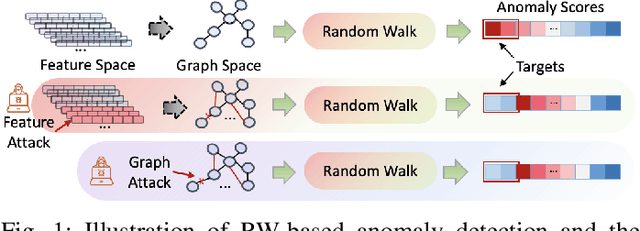
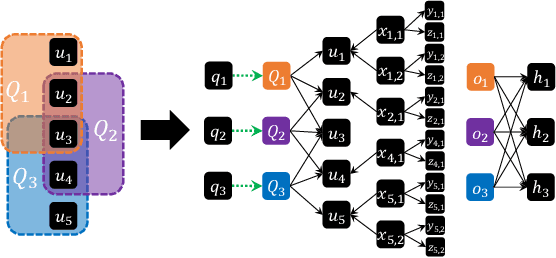
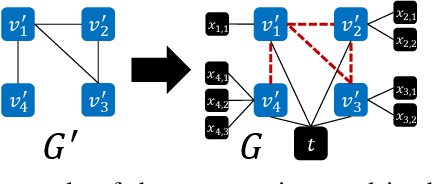
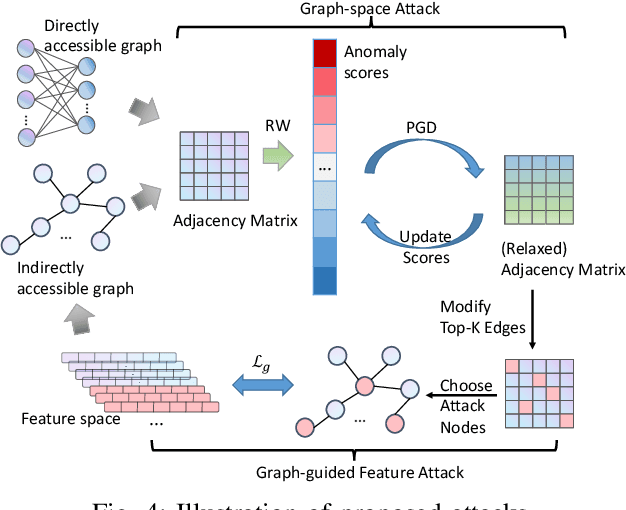
Abstract:Random Walks-based Anomaly Detection (RWAD) is commonly used to identify anomalous patterns in various applications. An intriguing characteristic of RWAD is that the input graph can either be pre-existing or constructed from raw features. Consequently, there are two potential attack surfaces against RWAD: graph-space attacks and feature-space attacks. In this paper, we explore this vulnerability by designing practical dual-space attacks, investigating the interplay between graph-space and feature-space attacks. To this end, we conduct a thorough complexity analysis, proving that attacking RWAD is NP-hard. Then, we proceed to formulate the graph-space attack as a bi-level optimization problem and propose two strategies to solve it: alternative iteration (alterI-attack) or utilizing the closed-form solution of the random walk model (cf-attack). Finally, we utilize the results from the graph-space attacks as guidance to design more powerful feature-space attacks (i.e., graph-guided attacks). Comprehensive experiments demonstrate that our proposed attacks are effective in enabling the target nodes from RWAD with a limited attack budget. In addition, we conduct transfer attack experiments in a black-box setting, which show that our feature attack significantly decreases the anomaly scores of target nodes. Our study opens the door to studying the dual-space attack against graph anomaly detection in which the graph space relies on the feature space.
How Fraudster Detection Contributes to Robust Recommendation
Nov 22, 2022Abstract:The adversarial robustness of recommendation systems under node injection attacks has received considerable research attention. Recently, a robust recommendation system GraphRfi was proposed, and it was shown that GraphRfi could successfully mitigate the effects of injected fake users in the system. Unfortunately, we demonstrate that GraphRfi is still vulnerable to attacks due to the supervised nature of its fraudster detection component. Specifically, we propose a new attack metaC against GraphRfi, and further analyze why GraphRfi fails under such an attack. Based on the insights we obtained from the vulnerability analysis, we build a new robust recommendation system PDR by re-designing the fraudster detection component. Comprehensive experiments show that our defense approach outperforms other benchmark methods under attacks. Overall, our research demonstrates an effective framework of integrating fraudster detection into recommendation to achieve adversarial robustness.
 Add to Chrome
Add to Chrome Add to Firefox
Add to Firefox Add to Edge
Add to Edge